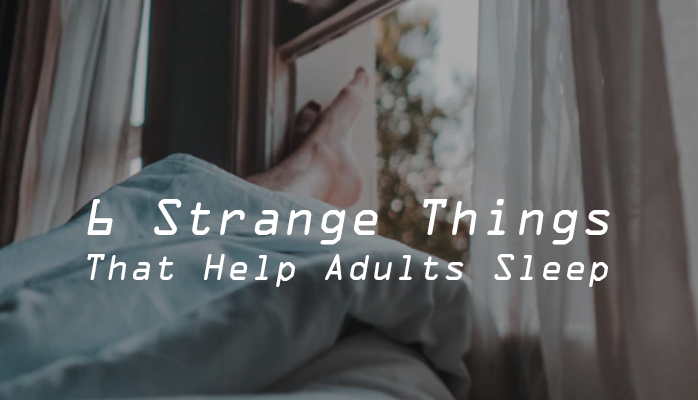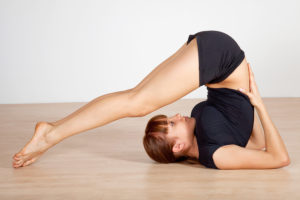
Not being able to sleep is frustrating. You may have already tried the common suggestions like having a sleep routine, avoiding too much caffeine and alcohol before bed, and so on. Fortunately, there are creative ways to help you get to sleep. Here are six strange but well researched, proven ways to sleep better that may help you.
1 - Rock Yourself To Sleep
A recent study on sleep and rocking found that rocking helps adults sleep more deeply and wake up fewer times during sleep. This study monitored 18 adults over three nights who slept in bed that rocked gently. Electrodes recorded brainwave activity throughout each night. The results concluded that the adults slept better, deeper, and longer when they were in the rocking bed.
Rocking before bed may help the onset of sleep, such as in a rocking chair or certain yoga exercises that involve rocking.
2 - Adopt a Bedtime
Bedtimes aren’t just for children. Having a consistent bedtime that you rigorously follow is an extremely important part of setting your biological clock. Even on weekends, try to stick to your bedtime as closely as possible.
Of course, having a bedtime is easier said than done. Some of the hardest parts about sticking to a bedtime are:
- Having children, who don’t always cooperate with your plans
- Having laptops and screens whose blue light suppresses the onset of melatonin
- Using applications (social media, YouTube, etc.) that have extensive functionality designed to keep you using the app
- Weekends, where you want to have fun and do things!
- Traveling, which makes it hard to keep any kind of schedule
Obviously, there will be interruptions in setting your bedtime, but staying diligent with it as much as reasonably possible can do wonders for sleeping.
3 - Do the Same Exact Activity Every Night Right Before Bed
You can condition yourself to queue up for bed in response to some kind of stimulus or consistent activity. It's like you're training your brain for sleep.
This tip is slightly different than having a pre-bedtime sleep routine, of which you may have already heard. This is doing the same exact activity right before bed, such as:
- Listening to a particular song
- Doing a particular activity, such as ringing a bell
- Smelling a particular smell, such as lighting a candle or essential oil
- Doing a series of basic activities in an exact order, such as closing your book, then turning out the light, then taking a big deep breath in and out, and then counting backwards from 20 – it can be whatever series of actions you want so long as it’s the same
You can a series of activities or one activity, but the point is to do it every night, without fail, just before you try and go to sleep.
4 - Breathing Exercise That are Extremely Effective

There is a yogic breathing exercise that is great for sleep. It’s called the 4-7-8 breathing technique and it works like this:
- Close your eyes and lie on your back in bed
- Place the tip of your tongue on the roof of your mouth just above your teeth – your tongue should stay here for the whole exercise
- Forcefully exhale completely through your mouth by pushing the air out with your belly
- Close your mouth and inhale slowly and quietly through your nose for four seconds (slow seconds!)
- Hold your breath and count to seven
- Exhale completely through you mouth for eight seconds, making a “whoosh” sound at you exhale
- Deep inhale through your nose, and repeat steps 3-7 THREE times, remembering to only inhale through your nose and exhale through your mouth
This breathing technique might sound odd but it works because: oxygen relaxes the parasympathetic nervous system and promotes relaxation.
5 - Sleep in a Cooler Room
Our bodies prepare us for sleep in response to two things:
- Changes in light (from light to dark)
- Cooling of temperatures at the onset of nighttime
Biologically, our bodies are designed to sleep at the night when it is cold. Keeping a cooler room at night tells our bodies that it’s night time, and time for sleep. Colder rooms queue our bodies to produce melatonin, which will help you get to and stay asleep. Furthermore, if you are in a hot room, you are more likely to wake up.
A “cooler” room doesn’t mean a “cold” room necessary, but a temperature that is cooler than what you would normally keep your room at. For example, a temperature between 60-68 degrees is reasonable.
Take a Hot Bath Before Bed
Like sleeping in a cooler room, taking a hot bath before bed simulates the same “cooling” effect that tricks your body into producing melatonin.
Why does taking a hot bath do this? Because after you get out of a hot bath, your core temperature experiences a drop – the same kind of drop your temperature would experience if you were outside during the transition from day to night.
Taking a hot bath right before bedtime will queue your body to start producing melatonin.
What if You Still Can’t Sleep?
If you have tried these tricks and everything else, there may be deeper underlying issues that are causing you to not sleep properly, such as:
- Insomnia
- Circadian rhythm disorders
- Restless leg syndrome
If you live in Alaska and still can’t sleep, take our online sleep test and get in touch with our sleep specialists.

